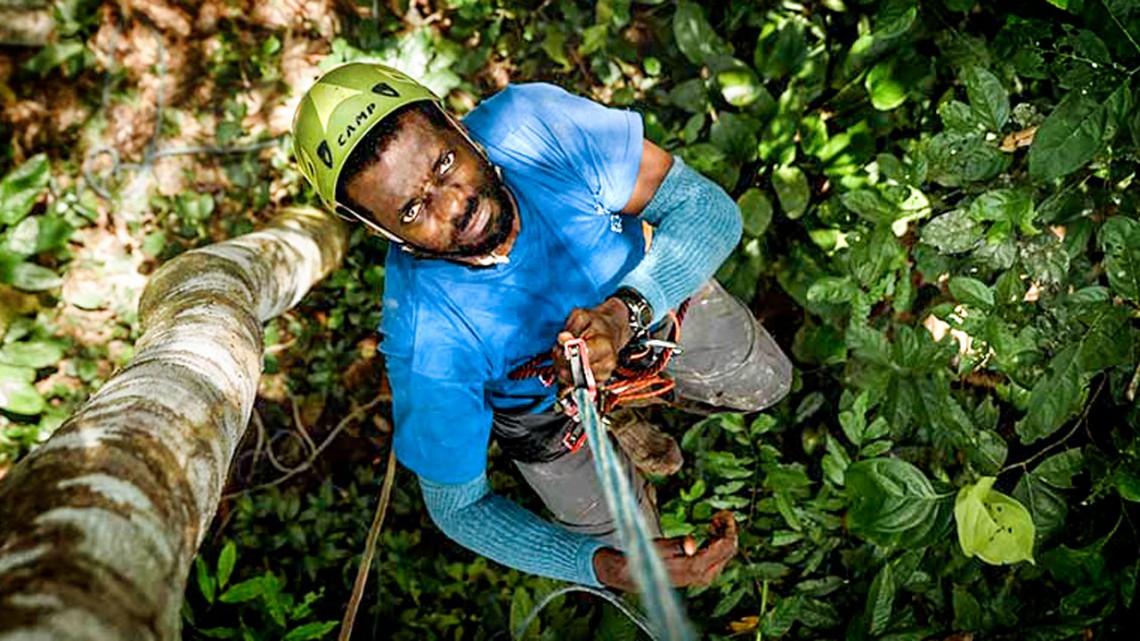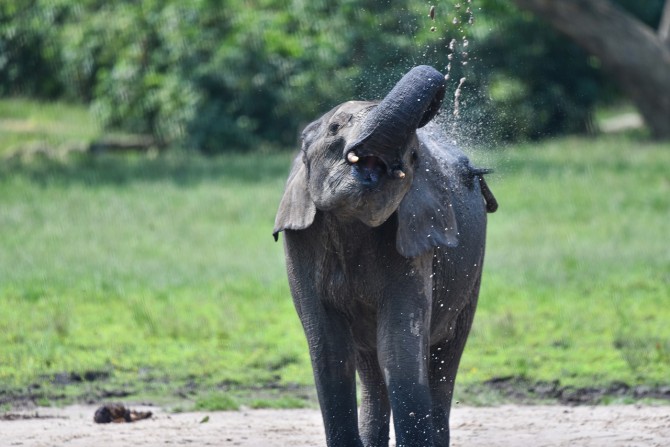
Frelcia Bambi is a member of the Congolese team that deploys sound recorders in the rainforest and analyzes the data. Photo by Sebastien Assoignons, courtesy of the Wildlife Conservation Society.
Elephant project recordings evoke the rainforest
By Pat Leonard
More than a million hours of sound recordings are available from the Elephant Listening Project (ELP) in the K. Lisa Yang Center for Conservation Bioacoustics at the Cornell Lab of Ornithology – a rainforest residing in the cloud.
ELP researchers, in collaboration with the Wildlife Conservation Society, use remote recording units to capture the entire soundscape of a Congolese rainforest. Their targets are vocalizations from endangered African forest elephants, but they also capture tropical parrots shrieking, chimps chattering and rainfall spattering on leaves to the beat of grumbling thunder.
“Scientists can use these soundscapes to monitor biodiversity,” said ELP director Peter Wrege. “You could measure overall sound levels before, during and after logging operations, for example. Or hone in on certain frequencies where insects may vocalize. Sound is increasingly being used as a conservation tool, especially for establishing the presence or absence of a species.”
For the past four years, 50 tree-mounted recording units have been collecting data continuously, covering a region that encompasses old logging sites, recent logging sites and part of the Nouabalé-Ndoki National Park in the Republic of the Congo. The sensors sometimes capture the booming guns of poachers, alerting rangers who then head out to track down the illegal activity.
But everyday nature lovers can tune in rainforest sounds, too.
“We’ve had requests to use some of the files for meditation or for yoga,” Wrege said. “It is very soothing to listen to rainforest sounds – you hear the sounds of insects, birds, frogs, chimps, wind and rain all blended together.”
But, as Wrege and others have learned, big data can also be a big problem. The Sounds of Central African Landscapes recordings would gobble up nearly 100 terabytes of computer space, and ELP takes in another eight terabytes every four months. But now, Amazon Web Services is storing the jungle sounds for free under its Open Data Sponsorship Program, which preserves valuable scientific data for public use.
This makes it possible for Wrege to share the jungle sounds and easier for users to analyze them with Amazon tools so they don’t have to move the massive files or try to download them.
Searching for individual species amid the wealth of data is a bit more daunting. ELP uses computer algorithms to search through the recordings for elephant sounds. Wrege has created a detector for the sounds of gorillas beating their chests. There are software platforms that help users create detectors for specific sounds, including Raven Pro 1.6, created by the Cornell Lab’s bioacoustics engineers. Wrege says the next iteration, Raven 2.0, will make this process even easier.
Wrege is also eyeing future educational uses for the recordings which he says could help train in-country biologists to not only collect the data but do the analyses. This is gradually happening now in the Republic of the Congo – ELP’s team of Congolese researchers does all the analysis for gunshot detection, though the elephant analyses are still done at ELP.
“We could use these recordings for internships and student training in Congo and other countries where we work, such as Gabon,” Wrege said. “We can excite young people about conservation in Central Africa. It would be a huge benefit to everyone living there.”
The Elephant Listening Project’s work in the Republic of the Congo is funded by the U.S. Fish and Wildlife Service, the Born Free Foundation and K. Lisa Yang ‘74.
To listen or download clips from Sounds of the Central African Landscape,
go to ELP’s data page on Amazon Web Services. You’ll need to create an account with AWS (choose the free option). Then sign in with your username and password. Click on the “recordings” item in the list you see, then “wav/” on the next page. From there you can click on any item in the list to play or download clips that are each 1.3 GB and 24 hours long.
Scientists looking to use sounds for research and analysis should start here.
Pat Leonard is a staff writer at the Cornell Lab of Ornithology.
Media Contact
Get Cornell news delivered right to your inbox.
Subscribe

